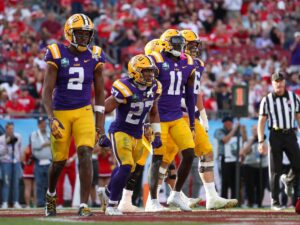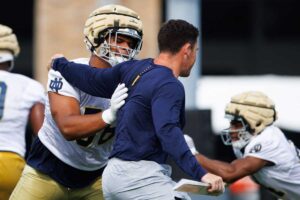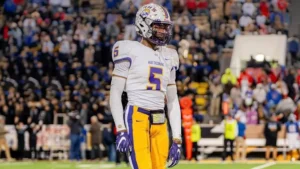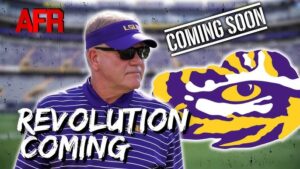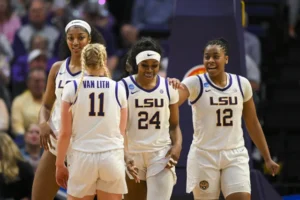
Notre Dame Football: Spring Practice Answers Key Questions Ahead of 2025 Season
As the echoes have quieted down in South Bend following the conclusion of Notre Dame’s spring practice, the Irish faithful can take solace in knowing that many of the program’s most pressing questions heading into the offseason have been met with clarity and confidence. A program rich in tradition and consistently operating under the weight of high expectations, Notre Dame entered spring ball with several key areas of uncertainty. From quarterback play and offensive line cohesion to defensive leadership and the integration of new coaching staff, the spring provided important insight into what fans can expect this fall.
Here’s a comprehensive look at the major question marks that have already been addressed ahead of the 2025 season.
1. Quarterback Situation Settled with Riley Leonard’s Command
The biggest storyline heading into the spring revolved around Duke transfer Riley Leonard and his integration into the Irish offense. Leonard, who missed the latter half of the 2024 season with an ankle injury, came to Notre Dame with high expectations after a strong 2022 campaign in the ACC. The question was not whether he had the talent—he’s proven that—but whether he’d be healthy, fully adapted to a new scheme, and able to command a locker room that saw multiple QB changes a season ago.
By all accounts, Leonard has exceeded expectations. He’s looked sharp in 7-on-7 work and full scrimmage situations, showcasing both his mobility and improved accuracy on intermediate routes. More importantly, Leonard has emerged as a vocal leader, earning the respect of teammates and coaches alike. His chemistry with the receivers is progressing well, particularly with standout wideout Jaden Greathouse and sophomore burner Braylon James.
With Leonard healthy and asserting control over the offense, Notre Dame appears to have found the stability it desperately needed at the quarterback position.
2. Offensive Line Taking Shape Despite Departures
The loss of veteran linemen Joe Alt and Zeke Correll left big shoes to fill, both literally and figuratively. Notre Dame has long prided itself on producing elite offensive linemen, but continuity and leadership were immediate concerns heading into spring ball.
Fortunately for Marcus Freeman and new offensive line coach Joe Rudolph, the next wave of Irish trench warriors looks ready to take the mantle. Senior guard Andrew Kristofic has emerged as the emotional leader of the unit, while junior tackle Blake Fisher has elevated his game, showing improved footwork and poise against Notre Dame’s deep defensive front.
Perhaps the most pleasant surprise has been early-enrollee freshman Liam Andrews, who’s pushing for playing time at guard and has impressed with his physical maturity and football IQ. While there’s still time before a definitive starting five is set, the group showed consistent improvement throughout the spring, and cohesion seems to be building at the right time.
3. Wide Receiver Room Finally Has Depth and Playmaking
For years, the wide receiver position has been a source of criticism for Notre Dame’s offense—a position group that struggled with separation, drops, and overall explosiveness. But this spring has signaled a major shift.
Sophomore Rico Flores Jr. has blossomed into a true WR1 candidate, showing strong hands and route refinement. Jaden Greathouse continues to be a reliable chain-mover, and the emergence of early enrollee Micah Gilbert, a top-100 recruit from North Carolina, has injected a new level of excitement.
Additionally, Chris Tyree’s return to the receiver group as a full-time slot option has opened up more versatility within the offensive scheme. Offensive coordinator Mike Denbrock’s creativity with formations and motion has allowed these receivers to shine in different roles, pointing toward a more dynamic passing attack this fall.
4. Defensive Line Depth Looks Like a Strength
Notre Dame’s defensive line depth was a minor concern entering the spring, particularly after the departures of key contributors like Howard Cross III. However, spring practice has shown that Al Washington’s unit may actually be a hidden strength.
Rylie Mills has taken on a leadership role and looks like a future NFL draft pick with his blend of size, power, and explosiveness. Juniors Jason Onye and Tyson Ford have made the leap many hoped for, showing consistency and gap discipline. The Irish also got a boost from Arkansas State transfer defensive tackle Terry Simmons, who brings maturity and a relentless motor.
Notre Dame may not have a Chase Young-type headline pass rusher, but the unit’s rotation, balance, and physicality have been evident throughout camp. If the defensive line can pressure quarterbacks by committee, the defense will be in a strong position.
5. Linebacker Room Finds a New Core
With the graduation of JD Bertrand and Marist Liufau, Notre Dame had to find not just production but leadership at linebacker. The answer came quickly as Jaylen Sneed stepped into the “Alpha” role many projected for him when he arrived as a five-star recruit.
Sneed’s athleticism and sideline-to-sideline play have stood out, but it’s his improved communication and football IQ that have made him a breakout figure this spring. He’s been joined by Nolan Ziegler and Drayk Bowen, two young linebackers who play with physicality and a nose for the football. The trio has built chemistry fast, and linebackers coach Max Bullough has spoken openly about their potential to form the next great Irish linebacker unit.
Bowen, in particular, has been a standout in goal-line packages and has flashed serious playmaking potential in short-yardage and red zone scenarios.
6. Safety and Cornerback Rooms Offering Flexibility and Stability
Al Golden’s defense relies heavily on versatility in the secondary, and Notre Dame looks poised to deliver in that department. After initially entering spring with some concerns about replacing DJ Brown and Thomas Harper, the Irish have seen key development across the board.
Xavier Watts, last year’s national interception leader, has continued to play at an elite level and now brings veteran savvy to the safety group. He’s joined by Ben Minich, a rangy athlete who’s improved in coverage and has looked solid in deep-zone responsibilities.
Cornerback play was already solid with Benjamin Morrison returning as one of the nation’s top lockdown corners. But the emergence of Christian Gray and transfer addition Jabari Johnson has added valuable depth and scheme flexibility. Golden has experimented with more nickel and dime looks, and the early results have been promising.
7. Special Teams Reload with Familiar Faces and New Talent
Special teams often fly under the radar in spring discussions, but with the departure of punter Bryce McFerson and questions at kicker, Notre Dame needed to find answers.
Kicker Spencer Shrader’s graduation opened the door for redshirt freshman Daniel Capen, who has looked consistent from inside 45 yards. While it’s still early, Capen appears to have the leg strength and calm demeanor needed for the job. Meanwhile, sophomore punter Tyler Klein has impressed with hang time and directional accuracy.
The return game will likely feature a mix of veterans, including Tyree and Greathouse, giving the Irish options and explosiveness in field position battles.
8. New Coaching Staff Gelling Well Under Marcus Freeman
The offseason staff changes—most notably the return of Mike Denbrock as offensive coordinator—raised questions about cohesion. But throughout the spring, Freeman’s leadership has been evident. The staff has gelled quickly, with Denbrock already making a strong impression by implementing a scheme that balances physicality with creativity.
Players have praised the clarity of communication and the unified approach. Defensive continuity under Al Golden remains strong, while Denbrock’s experience working with dual-threat quarterbacks like Riley Leonard has brought a fresh look to the offensive side of the ball.
Freeman’s presence continues to grow, both as a recruiter and a sideline leader. He’s building a culture where adaptability meets accountability, and this spring provided evidence that the foundation is not only intact but strengthening.
Notre Dame entered spring football with a laundry list of concerns, but they’ve emerged with far more answers than questions. From the quarterback room to the trenches, from coaching chemistry to player development, the Irish look like a team ready to contend again in 2025.
Of course, more challenges await in fall camp and as the schedule looms—with marquee games against USC and Texas on tap. But for now, Marcus Freeman and his staff can take a deep breath. Spring practice did its job.
